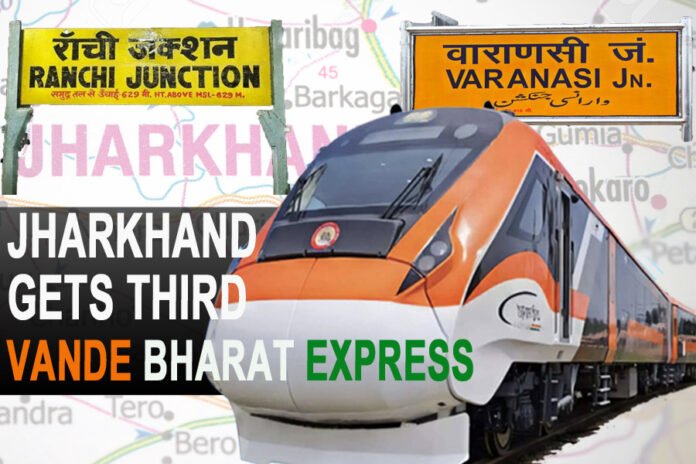On Tuesday, Jharkhand welcomed a new Vande Bharat Express train that will run between the state capital Ranchi and Varanasi in Uttar Pradesh. The inauguration was conducted virtually by Prime Minister Narendra Modi from Ahmedabad, along with the announcement of various railway projects in the state and nationwide.
Meanwhile, the PM also flagged off the Hatia-Asansol Express beside launching the Ranchi-Bondamunda railway line.
The PM inaugurated stalls at various stations in Ranchi under the ‘One Station One Product’ scheme, including Hatia, Govindpur Road, Itki, Muri, Piska, Silli, Tangarbasuli, Tatisilwai, Barkakana, Ranchi Road, and Pradhan Khanta stations. He meanwhile, also inaugurated the Gatishakti Cargo Terminals at HURL Sindri in Dhanbad district and North Urimari in the Barka-Sayal area of Central Coalfields in Ramgarh district.

The scheduled operation of the Ranchi-Varanasi Vande Bharat Express is set to commence on March 18th. This high-speed train will operate six days a week, with the exception of Thursday, covering the 571 km distance in a swift seven hours and fifty minutes.
The cost of travel from Ranchi to Varanasi will amount to Rs 2,325 for the Executive AC Chair Car, and Rs 1,160 for the AC Chair Car excluding meal service.
As per the schedule, it will leave Ranchi at 5.10 am and arrive at Varanasi at 1 pm. While returning, it will depart Varanasi at 4.05 pm and arrive at Ranchi at 11.55 pm. As per reports, the train will have stops at Muri Junction, Bokaro Steel City Junction, Koderma, Gaya Junction, Sasaram, and Pt. Deen Dayal Upadhyay Junction.
What changes as India implements CAA?
The inaugural journey of Jharkhand’s premier Vande Bharat Express, linking Ranchi and Patna, commenced on June 27, 2023. Subsequently, the second Vande Bharat Express connecting Ranchi and Howrah was launched on September 24 last year.
Notably, the Vande Bharat Express is a superfast express service operated by Indian Railways. It offers reserved, air-conditioned chair car service and connects cities that are less than 800 km (500 mi) apart or take less than ten hours to travel by existing services. The train was introduced into commercial service on February 15, 2019.



